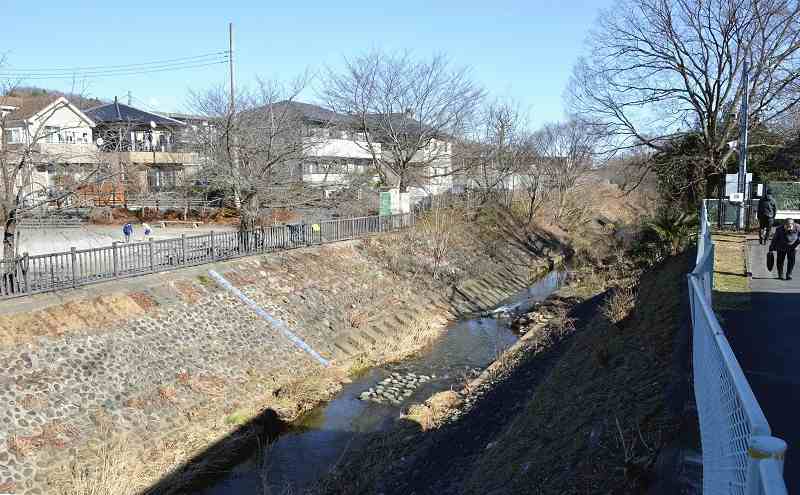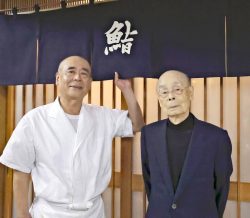
In this view of the Sakai River from the Kotobuki Bridge, with Machida, Tokyo, on the left and Sagamihara, Kanagawa Prefecture, on the right, the open area at left had been part of Sagamihara before the river was rerouted, but it has now been incorporated into Machida.
16:33 JST, April 13, 2021
Rumor has it that part of Machida in Tokyo has become part of the neighboring prefecture of Kanagawa. This rumor quickly began to spread around town last December, saying the city of Machida, whose links with Kanagawa have often become a topic of conversation, has at long last been incorporated into the other side. As I probed into the truth, I came across the existence of a stretch of river that is deeply engraved in local history. Not only did the rumor turn out to be true, but the reverse has also happened.
The city of Machida is located at the southern tip of the Tama area in western Tokyo. On a map, Machida resembles a wedge jutting south from Tokyo into Kanagawa.
I took a train on the JR Yokohama Line to visit Machida Station. Just south of the station runs the border between Tokyo and Kanagawa, with the nearby intersection Machida Station South located in Sagamihara, Kanagawa Prefecture. As I walked down the street, I saw that the buses running there are those of Kanachu (Kanagawa Chuo Kotsu). Forgive me for saying so, but I can now understand why the city is sometimes teased as being “the city of Machida, Kanagawa Prefecture.”
Still, it is a serious matter if the city has indeed been incorporated into Kanagawa Prefecture. So I asked Osamu Nagano, 58, chief of a section of the Machida city government’s general affairs division, whether the rumor is true or not. He bluntly admitted that the rumor is in fact true. He said the city “has been eliminating noncontiguous plots, which exist on both sides of the river that borders Tokyo and Kanagawa.”
These noncontiguous territories came about because the boundary between Tokyo and Kanagawa that separates the cities of Machida and Sagamihara was originally set along the Sakai River, which runs southeast from the western part of Machida. However, the meandering river has often risen and overflowed, so since the 1980s both the Tokyo metropolitan government and the Kanagawa prefectural government have been carrying out construction work to straighten the course of the river. Meanwhile, the border separating Tokyo and Kanagawa remains sinuous. As a result, noncontiguous territories of both cities have been created here and there on both sides of the river.
An altered border
Since around the mid-1990s, both cities have been working on projects to alter the border along the river to eliminate often-inconvenient detached plots. There have been cases in which the city of Machida had its isolated plots that are located across the river incorporated into the city of Sagamihara, and naturally, the reverse has also occurred.
Nagano, who became in charge of the project two years ago and learned the detailed content of the project, said he was surprised at “such a far-reaching plan.”
With the consent of the landowners, these detached territories, dotted here and there for about 20 kilometers along the river, have been eliminated one by one. Now, detached territories over a total stretch of more than 12 kilometers have been eliminated. The recent rumor actually stemmed from the latest elimination of an isolated plot of the land in December last year.
After an about 15-minutes walk north from JR Hashimoto Station (in Sagamihara), I came across the Sakai River. A plot of land beyond the river across Kotobuki Bridge is part of Machida. I spoke with Yoshiyuki Hiruma, the 73-year-old head of a neighborhood association in Machida.
The latest elimination of an isolated plot occurred right around this area. Oyama-machi Mitsume Hiroba open space, which is located on the north side of the river and had long been a piece of detached land of Sagamihara, has also been incorporated into Machida recently.
The plot of land, which was once located beyond the river, at least to Hiruma and his neighbors, became absorbed into Machida due to the river conservation work, and the open space was created. At the open space, Hiruma and other members of the neighborhood association mow the grass and take care of the flower gardens, and community events such as a summer festival and radio gymnastic exercises have been held. This means that they have repeatedly and unwittingly crossed the prefectural border, even without crossing the bridge.
Hiruma said he was not aware of the rumor, which had much to do with an unusual development connected to the river. “It seems strange that the open space, which we have long been familiar with, belonged until recently to Kanagawa Prefecture. As it has now become part of Machida, both in name and reality, we have to use it ever more carefully,” Hiruma said with a wry smile.
Separate provinces, connected people
According to Hideo Kuwahara, 81, who is knowledgeable about the history of the Sakai River and also serves as a tourist guide in Machida, a record on a land survey conducted in the 16th century at the order of warlord Toyotomi Hideyoshi states that there was “a river called the Sakai River, bordering the provinces of Sobu (Sagami and Musashi).” With this description, we learn that the river was considered, even in those bygone days, as a boundary between the two provinces of Sagami and Musashi.
There are also plenty of rumors related to this river from olden times. For instance, a kappa, a water goblin that mainly haunts rivers, was witnessed to have dragged into the river some of those who were on their way from the Machida side to pay a visit to a shrine on the Sagamihara side. There was also a bridge popularly dubbed a “relationship-dissolving bridge” that was loathed by people because a bride was said to have disappeared during her nuptial procession crossing the river via the bridge.
“The Sakai River not only separated the provinces, it also served as [a waterway] across which people living on either side interacted vigorously with each other,” Kuwahara said. “Even
today, with the issue of the detached plots, it has given birth to various dramas in local communities.”Related Tags
"Features" POPULAR ARTICLE
-

Sanrio to Open Museum in Yamanashi Pref. Dedicated to Founder, Exhibits Include Hello Kitty, Other Characters
-

Legendary Sushi Chef Jiro Ono Turns 100: ‘I Have No Regrets’
-

Autumn Foliage Surrounds Visitors to Tokyo’s Showa Kinen Park
-

My Daughter No Longer Speaks to Me, But I Want to See Her and My Grandchild
-

Kumamoto: Public Bath Refurbished as Library Where You Can Chat, Take Photos
JN ACCESS RANKING
-

Keidanren Chairman Yoshinobu Tsutsui Visits Kashiwazaki-Kariwa Nuclear Power Plant; Inspects New Emergency Safety System
-

Imports of Rare Earths from China Facing Delays, May Be Caused by Deterioration of Japan-China Relations
-

University of Tokyo Professor Discusses Japanese Economic Security in Interview Ahead of Forum
-

Japan Pulls out of Vietnam Nuclear Project, Complicating Hanoi’s Power Plans
-

Govt Aims to Expand NISA Program Lineup, Abolish Age Restriction

























